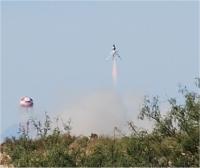I present here a compilation of major news and events
in NewSpace
during the year 2007. Most of the list came from postings
on my Space
Transport News blog, which had over 2000 entries
in 2007. It's a subjective list, of course, and I surely
left out some items that others might think should be
included.
There were many positive developments during 2007 but
also a number of disappointments and setbacks. Overall
there was a net positive step upwards and the year sets
the stage for even bigger steps to be made in the next
couple of years.
The primary goals of NewSpace are to bring about significantly
lower cost access to space and to involve a much larger
segment of society in space activities. These goals
came a bit closer in 2007 but are still not quite within
reach. This posting - Slow
revolutions ... - Space Transport News - June.23.07
- summarizes how I view the process that is happening
with entrepreneurial spaceflight.
To make some sense of the great number of entries,
I've partitioned the review into the following categories.
For each category, I split the entries into Ups
and Downs according to whether the events represented
positive or negative steps towards NewSpace goals.
|
|
Armadillo
Aerospace's Mod vehicle comes in for a landing on
the first leg of its first attempt at
the Northrop Grumman Lunar Lander Challenge prize at
the X PRIZE Cup on Oct.27, 2007.
See X
PRIZE Cup 2007 review.
Downs:
- By far, the worst event for NewSpace in 2007 was
the tragedy in Mojave on July 26th when the Scaled
Composites engine test stand exploded and killed
Glen
May, Eric
Blackwell, and Todd
Ivens. The exact cause of the accident was not
immediately known (there was no engine firing at the
time). For details, see the many Space
Transport News postings in July about the accident.
A safety panel report is expected to be released in
early 2008. The accident will delay the SpaceShipTwo
program by up to a year.
- Fuel sloshing in the second stage prevented the
SpaceX
Falcon 1 from putting a dummy payload into orbit on
its second
test flight.
- Armadillo
Aerospace failed to win either level 1 or 2 of
the Lunar
Lander Challenge (LLC) due to ignition problems
with their engines.
- None of the other 9 teams that signed up for the
LLC made it to the competition.
- Rocketplane
Kistler (RpK) failed to attract sufficient investment
to meet its COTS
milestones and its agreement with NASA was terminated.
- Congress cut funding for the COTS
ISS resupply program for 2008 and placed restrictions
on the the second round competition that would use
money made available by the RpK agreement cancellation.
- Delays for most of the "land, refuel and fly"
types of suborbital spaceflight projects and only
Blue
Origin and Armadillo
had untethered rocket-powered test flights (as far
as we know).
- Bigelow
Aerospace has not yet been able to arrange transportation
to the Sundancer for crew visits after it launches
in 2010.
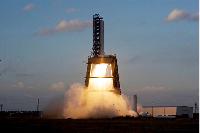
Falcon 9 first
stage firing tests began in the autumn in Texas.
Ups:
- Before its second test flight, the Falcon
1 had an amazingly fast one hour turnaround after
a hot fire abort. This is exactly the sort of operational
robustness that must be achieved with rocket technology
before we can obtain low cost access to space.
- Falcon
9 passed a major design review and the first
stage firing tests began. A new Merlin engine
was developed. Dragon capsule also passed
a design review.
- Armadillo
Aerospace carried out dozens of tethered and untethered
flight tests at the Oklahoma spaceport, including
a full LLC Level 2 flight sequence.
- Armadillo announced the development of the modular
vehicle concept. Modules can be combined to achieve
high altitudes. Armadillo built and flew Mod within
a couple of months.
- Armadillo got an Air Force SBIR grant for vehicle
development.
- Several of the LLC teams made good progress even
though they weren't ready for the X Prize Cup in October.
Some of them should begin test flights in early 2008.
- Blue
Origin flew Goddard twice untethered in 2007.
Unknown if they did tethered flights.
- Blue
Origin began construction of a second vehicle
that should go to high altitudes.
- New COTS round attracted several impressive proposals
for ISS resupply systems. Some of the teams included
collaborations of new and old space firms. Assuming
funding cutbacks and restrictions are worked out,
the program should initiate at least one new low cost
space access project.
- AirLaunch
LLC continued to progress under its DARPA grants
towards an orbital test.
- XCOR
received Air
Force money to develop a high altitude (200k ft)
vehicle.
- XCOR began flying the first Rocket
Racer, which uses an engine with a piston
pump. XCOR will use similar engines for their
high altitude vehicles.
- ARCA
Space began flight tests of its balloon launched
suborbital spaceflight system.
- A Japanese suborbital RLV project was
announced that would continue the work started
with the RVT
reusable test vehicle. See also this
posting from the ISPS.
- Several small companies such as Masten
Space, TGV
Rockets, etc., continued to make progress with
their vehicle projects during 2007.
- Giant EADS Astrium unveiled
the design of a rocketplane
for the space tourism market. It is seeking over
1 billion Euros of investment to initiate development
of the vehicle.
- Bigelow announced
a study with Lockheed-Martin to investigate use
of the Atlas V 401 to send crew and cargo to their
habitats. (Lockheed-Martin had presented
studies at a conference that dealt with manned
flights with the Atlas V.)
NewSpace in Orbit
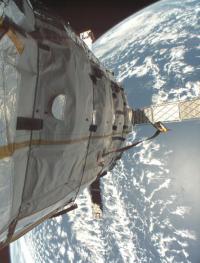
Genesis
II was launched into orbit on June 28, 2007 by a
Russian Dnepr rocket.
Ups:
- Bigelow Aerospace's Genesis
II made it to orbit and it and Genesis I continue
to work well.
- Bigelow announced they would skip the launch of
the intermediate Galaxy module and instead move directly
to a launch the crew capable Sundancer in 2010. See
the ambitious
plan that he laid out at the Space Foundation
symposium in April. See also this announcement
in August and this plan
to support capsule development.
- Several university and other small organizations
around the world launched low cost nanosats (e.g.
Cubesat based) into orbit in 2007.
Downs:
- No other entrepreneurial NewSpace style company
has gotten a major payload to orbit yet.
Entrepreneurial
Space/Rocket Related Businesses
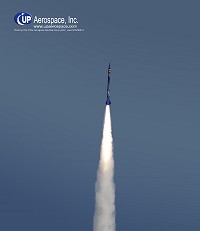
Image: Aerospace
Services Group
UP Aerospace
launched a Spaceloft XL vehicle on April 28, 2007 with
a flight
manifest
that included a diversity of items from commercial and
educational organizations.
Ups:
- UP
Aerospace had a successful public suborbital space
flight with commercial payloads. These included products
intended for retail, such as space related collectables,
that would use the cachet of having actually gone
to space and back as a selling point. An innovative
marketing idea came from Microgravity
Enterprises, Inc., which launched ingredients
to its Space2O
water and Antimatter
energy drinks.
- UP
Aerospace also had a successful
low altitude rocket flight to test equipment for
an unnamed client. They believe this sort of component
testing service will provide a significant market
for them. (Armadillo also had companies
talking to it about a similar service.)
- Celestis/Space
Services space burial company flew cremated remains
on the UP
Aerospace flight and has payloads ready for future
orbital and suborbital flights. They see a large market
for this service and need more frequent access to
space on low cost vehicles within the US (friends
and relatives of the deceased want to observe the
launches).
- ZERO-G seems
to be doing well. They now fly from both KSC and Las
Vegas. A flight
with Stephen Hawking attracted lots of publicity.
Northrop-Grumman continued sponsoring flights with
science teachers.
- The Rocket
Racing League announced it now has a full compliment
of teams, First X-Racer began test flights, and exhibition
events should start in 2008. First actual race in
late 2008 or early 2009.
Downs:
- Only one UP Aerospace flight to space.
- Rocket Racing didn't start exhibition events in
2007.
- No big breakout new space business emerged that
could prove to investors that this is a good area
to put their money.
Space Tourism
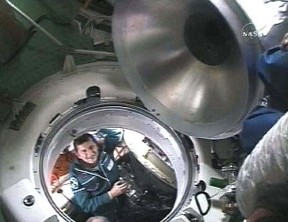
Charles
Simonyi enters the ISS.
Ups:
- Space
Adventures sent Charles Simonyi to the ISS and
announced that Richard Garriott will go next year.
Space Adventures says they have a queue for ISS flights
for the next several years.
- Virgin
Galactic has over 200 people who have paid deposits
or full ticket prices for SS2 flights. Virgin Galactic
detected no effect from the Scaled accident on sign
up rates for SS2 flights.
- Virginia
passed legislation to protect space tourist firms
from lawsuits for accidents.
Downs:
- Russian space agency says that after 2009 it will
not have enough flights for space tourists due to
the need to deliver the ISS crews (which will grow
to 6).
- The Scaled accident delayed SS2 development from
2009 to 2010.
- Other suborbital space tourism firms indicated
delays, which means there will probably be no test
flights to 100km in 2008.
Space Prizes

Ups:
- Space
glove Centennial Challenge was won by Peter Homer
(he was later hired by Orbital Outfitters).
- Centennial
Challenge competition events were held for space
glove, lunar regolith excavation, lunar landers, power
beaming, and tether strength.
- $30M Google
Lunar Prize announced.
- So far, one team, Odyssey
Moon, has officially signed
up so far.
- Another credible team led by Red Whittaker,
who led the winning team for the DARPA robot urban
driving contest, will sign up soon and promises
to fly by July 2009.
- A push began in Virginia to organized the V-prize
for a point-to-point suborbital flight demonstration
from Virginia to a European site.
Downs:
- Besides the space glove, no other Centennial Challenge
space competition was won. (The Personal
Air Vehicle CC did award out prize money.)
- Congress has refused to allocate additional money
for Centennial Challenge so that competitions for
additional technologies can be opened.
Finance
Ups:
Downs:
- RpK could not raise $500M for its COTS project.
- No new major angel investor like Bigelow or Bezos
entered the field (as far as we know).
- No major movement of venture capital or institutional
money into NewSpace.
Infrastructure
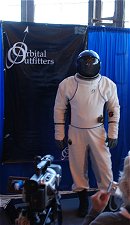
Orbital
Outfitters introduces their first spacesuit at the
X PRIZE
Cup 2007.
Ups:
- Orbital
Outfitters unveiled its first flight suit intended
for commercial suborbital spaceflight operators.
- Commercial spaceflight training is developing into
a real business for companies like the National
Aerospace Training & Research (NASTAR) Center.
Virgin Galactic's passengers have started experiencing
6Gs in their centrifuge, which is the level they would
experience during reentry on the SS2.
- XCOR
annnounced development of new engines, including a
LOX/Methane engine with ATK, and the success of its
piston pump program.
- Orion
Propulsion and C&Space
(South Korea) made progress with their LOX/Methane
engines. (Aerojet and Northrop-Grumman also announced
methane engine projects.)
- TGV
Rockets announced
development of a new
engine and a testing program at NASA Stennis.
- SpaceX completed
development of its upgraded Merlin 1C engine.
- Two tether tests in 2007 - YES2
and MAST
- both were partial successes.
Downs:
- Still no sign that a NewSpace rocket vehicle company
could build a vehicle using engines, structures, etc.
obtained from low cost NewSpace suppliers. Most of
the entrepreneurial launcher companies are still doing
in house development to obtain most of their major
components, especially engines.
Spaceports
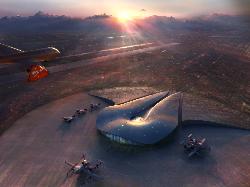
Winning design for Spaceport
America near Las Cruces, New Mexico
Ups:
Downs:
- The New Mexico spaceport authority first executive
director died and then his replacement resigned a
few months later.
- Appears that the ground breaking for the NM spaceport
at end of 2008 at earliest.
- Mojave spaceport had a safety
dispute with FAA, though this was
settled late in December.
|



